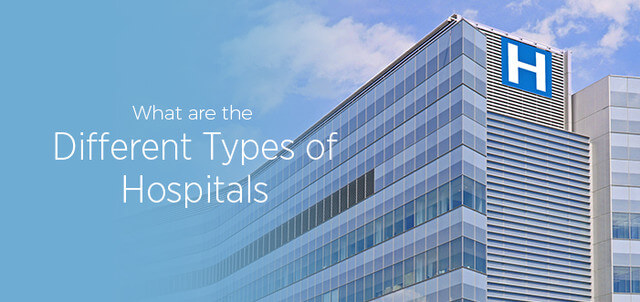
What Are the Different Types of Hospitals?
Gallagher Healthcare :: Industry Insights
By Gallagher Healthcare | 3/22/2018
With the growing complexity of the healthcare system, patients now have a considerable array of choices when it comes to receiving care from providers. This often includes the option of selecting what type of healthcare facility they wish to utilize from a long list of many. After all, the 2018 AHA Hospital Statistics reported here were 5,534 registered hospitals in the U.S.
And like the complicated healthcare industry, medical malpractice lawsuits tend to be one of the most complex types of legal claims requiring experts specializing in this type of law. One reason for this is the wide variety of types, features, locations and services of hospitals today.
With so many different types of hospitals and medical facilities, you may wonder what makes one hospital or facility different from another — and therefore, its medical malpractice coverage.

What Differentiates the Various Types of Hospitals?
In the U.S., you can differentiate hospitals based on a variety of factors that includes functionality, size, location, ownership and specialization. Here they are in more detail:
1. Functionality
Functionality refers to whether the hospitals are general-purpose, teaching hospitals, acute care facilities, long-term hospitals, community hospitals, research hospitals or if they provide trauma care for patients. It refers to how the hospitals themselves function within the communities they serve.
2. Size
There are three primary classifications when it comes to size:
- Small hospitals: Fewer than 100 beds
- Medium hospitals: 100 to 499 beds
- Large hospitals: 500 or more beds
Typically, these sizes are classified by the number of beds they have — although there can be some variation within these groups of hospitals and medical centers.
3. Location
You can also classify hospitals by their locations. Rural hospitals aid smaller communities and often have limited access to advanced equipment or specialized procedures and techniques. Since they also face competition, urban hospitals serve larger metropolitan areas and must often offer a wide degree of versatility when it comes to treatment options and patient experience.
4. Ownership
Knowing who owns the hospital will also tell you a great deal about how the hospital will operate. Some hospitals are part of larger networks that offer a streamlined approach to management. While some physicians feel this improves efficiency and patient experience, some feel it removes the emphasis from the patient and makes treatment less personal.

Private hospitals often offer access to the latest technologies and equipment, but may under-serve community members who need healthcare the most.
Government-supported facilities operate via grants and other public funds. They have greater restrictions but also reach out to members of the community who may not otherwise receive healthcare and medical treatment.
5. Specializations
Specialized hospitals appeal to physicians who entered the medical field with plans to treat people with a specific condition. Most physicians choose specializations due to personal reasons, an area of intense interest or a desire to provide a comfortable life for themselves and their families.
The Many Types of Hospitals
Now that you have a general idea of the main categories of hospitals, it’s time to explore individual types to learn more about what they have to offer.
There’s a vast array of types of hospitals out in the world today, so let’s get started.
Academic Medical Centers
Academic medical centers often serve specific medical schools or universities. Facilities like this offer a variety of services to treat the general healthcare needs of their communities as well as specialized services while simultaneously offering educational opportunities to students in the healthcare field.
Acute Hospitals
Acute hospitals focus solely on the treatment and care of people with short-term needs like the following:
- Illnesses
- Diseases
- Injuries
- Surgeries
- Surgery recoveries
- Obstetric care
- Postnatal care
They are not equipped to handle chronic or long-term care for patients. According to EOSCU, approximately 91 percent of hospitals are acute care facilities. Most people who are treated in acute care hospitals stay for 10 days or fewer.
Ambulatory Surgery Centers
Focusing on same-day surgical care, ambulatory surgery centers offer surgical procedures without requiring patients to be admitted to hospitals for the operation or recovery. They are cost-effective options for patients and provide a less stressful surgical environment than many hospitals can provide.
Children’s Hospitals
Children’s hospitals specialize in the care and treatment of children and the conditions that affect younger patients. It is a type of specialty hospital, which means the staff has received additional training to aid in the treatment of children for a variety of acute and long-term medical needs.
In addition to offering medical treatment to children, children’s hospitals are widely praised for the level of psychosocial support they offer the children in their care and their families — especially in the case of children who require long stays in the hospital.
Clinics
Clinics are typically much smaller than hospitals and operate solely on an outpatient basis. They aren’t equipped to keep patients overnight for recovery, treatment, diagnosis or observation. Government agencies may run clinics or they may operate as private entities and partnerships among surgeons or private physicians.

Community Hospitals
Non-teaching hospitals serving local communities without federal funding are known as community hospitals. They can be found in rural or urban settings and provide vital services to their local populations. The American Hospital Association reports that there are 4,840 community hospitals operating in the U.S. today.
District Hospitals
District hospitals serve as healthcare hubs for their geographic regions. They have more extensive intensive care facilities and long-term care programs in addition to providing necessary treatments in fields like obstetrics, general surgery, plastic surgery and more.
Federal Hospitals
Sometimes referred to as government hospitals, federal hospitals receive funding from the federal government. In the United States, federally funded hospitals typically handle the healthcare and medical needs of select populations such as Native Americans and Veterans.
For-Profit Hospitals
For-profit hospitals are investor-owned facilities. This means the profits they earn go to shareholders who have invested in the facilities rather than back into the hospital for improvements, new services and medical advancements. Some fifty-eight percent of hospitals today, according to EOSCU, are not-for-profit hospitals.

Free Hospitals
Free hospitals do not charge patients for the services they provide. They are generally located in areas that reach out to patients of poor socio-economic classes and frequently operate at a loss. As a result, they often struggle to provide the amenities and level of services many physicians strive to offer.
General Services Hospitals
General service hospitals focus on general and necessary services for the community, like:
- Surgery
- OB/GYN services
- Pediatric services
- General medical care
They offer little in the way of specialty services and may not be equipped to provide long-term care to patients. Most hospitals today are general services hospitals.
Government-Funded Hospitals
State or federal governments provide grants or public funding to government-funded hospitals to operate. Veterans hospitals are perhaps the most famous of these kinds of hospitals. EOSCU reports that there are currently 213 federally funded hospitals in the U.S.

Hospitals in a Network
Hospitals in a network operate in connection with one another to deliver a range of services to a single community or multiple communities. The benefits of becoming affiliated with a hospital network are mainly economic, as this helps to improve efficiency, eliminate redundancy in services and ensure the quality of care to all patients — whether in rural communities or larger cities.
Hospitals in a System
Hospital systems are a lot like hospital networks. Larger systems can offer specialty services as well as general services, though patients may have to travel to a different facility to have their needs met. This helps reduce costs for the hospitals while offering confidence among patients that they will receive a certain standard of care from any hospital within that system.
Independent Hospitals
Independent hospitals are becoming increasingly rare as healthcare costs rise and many hospitals look for the financial benefits network affiliation provides. However, there are still independent hospitals throughout the country finding great success while meeting the medical and healthcare needs of their communities.
Large Hospitals
Because they typically have 500 or more beds, large hospitals are capable of serving the broader needs of the community. Some larger hospitals offer a combination of acute and long-term care services while also providing research opportunities in some cases and accommodating a variety of specializations.
Local Hospitals
While once the backbone of healthcare in America, many local hospitals are either facing closure or being incorporated into larger healthcare systems so that they can continue to provide necessary services to their communities while meeting the substantial financial burdens local hospitals experience.
Long-Term Hospitals
Hospitals providing long-term care can meet the needs of patients suffering from chronic illnesses, requiring psychiatric care, cardiac rehabilitation, or who are going through extensive rehabilitation after accidents or injuries. This might include hospitals that offer burn centers, cancer centers, and similar types of care facilities.
Medium Hospitals
Medium hospitals usually have between 100 and 300 beds though some may have as many as 500 beds.
Municipal-Funded Hospitals
Municipal-funded hospitals are community hospitals funded, at least in part, by local governments. They are often small facilities that provide limited acute care services to local populations.
Non-Community Hospitals
This is another term used to reference federally funded or government hospitals. While community hospitals exist to serve the short-term acute care needs of the general public, non-community hospitals often provide for specific groups such as veterans or Native American populations.
Non-Teaching Hospitals
Non-teaching hospitals are unaffiliated with medical schools and do not provide educational opportunities for students studying to become doctors, nurses or other medical professionals. They provide necessary medical services to the communities they serve and often operate more cost-effectively, as they do not absorb the many costs associated with educating medical professionals of the future.
Not-for-Profit Hospitals
Nearly two-thirds of all hospitals located in urban areas are considered to be not-for-profit hospitals, meaning they are not beholden to shareholders to earn profits. Many of these nonprofit facilities receive tax benefits that are unavailable to for-profit facilities.

Osteopathic Hospitals
Focusing on diet and the environment to influence health as well as manipulation of the body, osteopathic hospitals take a holistic approach to healing and patient care. Rather than treatment, osteopathic hospitals tend to concentrate on preventative measures.
Private Hospitals
Owners and investors — who recover their investments via fees charged to the patients they assist or their insurance providers — provide funding for private hospitals. Facility owners and administrators determine the budget, manage finances and ensure compliance with various codes and regulations related to medical care.
Patients often prefer private hospitals because of the many offered amenities, better doctor-to-patient ratios and a variety of services that are unavailable in facilities that have more limited budgets.
Psychiatric Hospitals
Psychiatric hospitals attend to the mental health needs of their patients. The staff who work in them treat a variety of mental health conditions through the use of medications, psychotherapy and behavioral therapies. Some hospitals and treatment centers focus on short-term treatments while others offer long-term care for psychiatric patients.
Rehabilitation Hospitals
Rehab hospitals and treatment centers focus exclusively on patient rehabilitation for a variety of illnesses and injuries. Some facilities offer both inpatient and outpatient rehabilitation services while others focus exclusively on inpatient services and intensive therapy regimens.
Research Hospitals
Research hospitals commit their efforts to researching cures for certain conditions in addition to treating illnesses, diseases, injuries and various healthcare conditions. St. Jude Children’s Research Hospital may be one of the most famous research hospitals in the United States, but there are plenty more.
Rural Hospitals
Usually fitted with 100 or fewer beds, rural hospitals are located outside large urban areas and operate on small budgets. They generally provide basic care. If needed, they’ll transport patients in need of more critical care to larger hospitals in their regions.

Nearly 72 percent of all rural hospitals are defined as “critical access” hospitals, meaning they have fewer than 25 beds and are located 35 or more miles from the next-nearest hospital. According to American Hospital Association, there were 1,825 rural community hospitals in 2016.
Seniors’ Geriatric Hospitals
Geriatric or seniors’ hospitals exclusively treat aging adults. They focus on diseases and conditions that impact adults aged 65 and over. According to Psych Central, elderly patients who receive care in a specialized geriatric facility enjoyed a reduced risk of functional decline at discharge (18 percent lower) and a 30 percent higher likelihood of returning home upon leaving the hospital than those treated in general hospitals.
Small Hospitals
As the name implies, these are typically small-scale operations with fewer than 100 beds. Many of them are located in rural communities with no other hospital or medical center within short driving range or offer highly specialized treatment options.
Specialty Hospitals
Specialized hospitals are typically affiliated with larger hospitals or healthcare networks and offer specific treatments. You may find a variety of specialty hospitals within one community, including:
- Women’s hospitals
- Children’s hospitals
- Cardiac hospitals
- Oncology hospitals
- Psychiatric hospitals
- Trauma centers
- Cancer treatment centers
Specialty facilities typically excel at providing the types of services listed above while offering limited specialized care, other than the basics, for conditions outside their specialties.
State Hospitals
Many state hospitals are teaching hospitals that offer vital educational experiences to students while meeting the medical care and treatment needs of their communities. State hospitals often receive a substantial portion of their funding from the state, though they may also receive grants and endowments from charitable organizations in the communities they serve.
Super Specialty Hospitals
Super specialty hospitals offer highly specialized treatments along with a staff that has received extensive education and training in isolated conditions. They will often have cutting-edge equipment to offer highly sophisticated diagnostic and treatment options to the patients who visit them.
Specialized hospitals or units within hospitals may have access to treatment options that aren’t available at other hospitals, such as organ transplants, specialty medical devices and medications that require very precise handling and training to administer.
Teaching Hospitals
Typically affiliated with universities, colleges, medical schools or nursing schools, teaching hospitals provide medical and healthcare services while teaching and training healers of the future. The students, interns and fellows working and learning in these hospitals are all supervised by qualified physicians, teachers, department chairs and other medical staff.
Because teaching hospitals exist to provide educational opportunities to students, they often treat sicker patients, which may result in lower quality scores than non-teaching hospitals — even if the ranking is somewhat undeserved.
Trauma Center Hospitals
Trauma centers are hospitals specifically equipped to provide care for patients who have experienced traumatic injuries. These can be from a variety of occurrences, including:
- Falls
- Auto accidents
- Gunshot wounds
- Other life-threatening injuries
The American Trauma Society describes five levels that classify trauma centers. Requirements for classifications vary from one state to the next and most trauma center hospitals also have designations or levels assigned to adult trauma and pediatric trauma.
Trust Hospitals
Trust hospitals are either charitable hospitals or semi-charitable, with many charges funded through trusts. Some trust hospitals, widely used by middle-class patients, are referred to as “no profit, no loss” hospitals and they provide subsidized services.
Urban Hospitals

Nearly 62 percent of all community hospitals are urban hospitals. Urban hospitals provide services in areas with dense populations and range in size from 100 to 500 beds. Many urban hospitals face intense competition with multiple hospitals and medical centers serving the same geographic areas. In 2016, 3,015 urban hospitals were in operation, according to the American Hospital Association.
Veterans Affairs (VA) Hospitals
Veterans Affairs hospitals are tax-supported hospitals widely utilized by the men and women who have served their country in any branch of the Armed Forces. Treatment at VA hospitals is provided free of charge to veterans as thanks from a grateful nation for their service to the country.
Get Medical Malpractice Insurance for All Types of Hospitals
Today’s healthcare systems and their many facilities are complex and multi-faceted. And like the healthcare system itself, medical malpractice insurance is an intricate, omnipresent part of every hospital throughout the country and the physicians who practice within them.
On top of that, healthcare has evolved into an extremely litigious industry, resulting in hospitals paying high premiums to protect not only their employees but the hospital itself. While small hospitals may pay medical malpractice premiums of several hundred thousand dollars annually, large hospitals in highly populated urban areas can dispense payments of several million dollars per year.
Hospitals commonly carry a $1,000,000 per claim limit of liability, in addition to having a medical malpractice insurance policy covering excesses at much higher limits. For instance, hospital chains and large hospitals often carry excess liability limits in the neighborhood of $50,000,000.
And because frivolous lawsuits, medical errors and hospital negligence are unavoidable, going without medical liability insurance is not an option. Hospitals can protect themselves with medical malpractice insurance to cover the entire organization, including the NICU, the ICI, operating rooms and radiology department.
Healthcare institutions and providers need the world’s largest medical malpractice brokerage firm to help determine the appropriate coverages. Whether you operate a standalone community medical clinic, manage a group of physicians, are a solo practitioner or a hospital administrator, contact the medical malpractice experts at Gallagher Healthcare today to learn more about your coverage options and how you can benefit from the services we offer.
Give us a call at 800-634-9513 or request a free quote online.